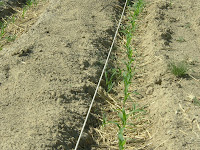This is an article I wrote for Hort news news letter
Rodent species that you might see in your garden include rabbits, prairie dogs, voles, mice, rats, and
pocket gophers. At some time in your gardening career you will have to deal with damage from one, some
or all of these furry friends.
You could use lethal methods to control a rodent attack on your garden. To get anything from traps to
poison and how to use them, all you need to do is go to your local garden center. Let’s look at some of the
trouble with traps and poisons. Traps can be slow and could draw more trouble in the form of predators
to your garden. At the very least, you will have to put up with the sight of the trapped rodent. Poisons
may target more than just the rodent you want to get rid of. Poisons will potentially harm any animal
that might eat the poison and second generation poisoning from any animal that eats the rodent that
consumed the poison originally. That not only includes hawks, eagles, coyotes, and owls, but your pets as
well.
I have found that even with traps and poisons the furry little critters will and do come back. How do
we get them to go to another location without the use of traps and especially poisons?
Let’s look at some alternative ways to control rodents:
• Take a good look at your landscape. Look for places for the rodents to hide, from you and predators.
If you have a cat, watch where it goes and where it is looking; chances are that the cat is looking for
something to kill. If you have a dog, let it roam. The dog will tell you by where it goes and where it is
sniffing that there is something in its area.
• If you don’t have a pet just look for woodpiles, piles of branches, trash, what ever.
• Look for holes in the ground that will tell you where the rodent lives.
• Look for trees that will act as cover for rodents from birds of prey; fences can keep rodents out but
will also keep predators out.
• If you have a fence, let your dog roam inside the fence line. Often, the scent of the dog will send
rodents from your garden to your neighbors’ garden where there is no scent of a predator.
Use the fact sheets from the CSU Extension office (this includes other states’ Extension offices you
can find online), the Division of Wildlife and The Humane Society of the United States to learn about the
habits of the rodents and do what you can to disturb their peace. Much of this information is available at
the Internet Center for Wildlife Damage Management, http://icwdm.org
I will change the environment first, attract predators, and use non-lethal methods to deter rodents
and use traps and baits as the very last resort to control rodents.
I like to learn what I can do before I go and dump poison out for all the other animals to eat. By using
this method I can enjoy the bounty of my garden, songbirds and even hawks, owls, nighthawks and once
an eagle. It can be a lot of work but with dedication you can enjoy your garden and the wildlife.




